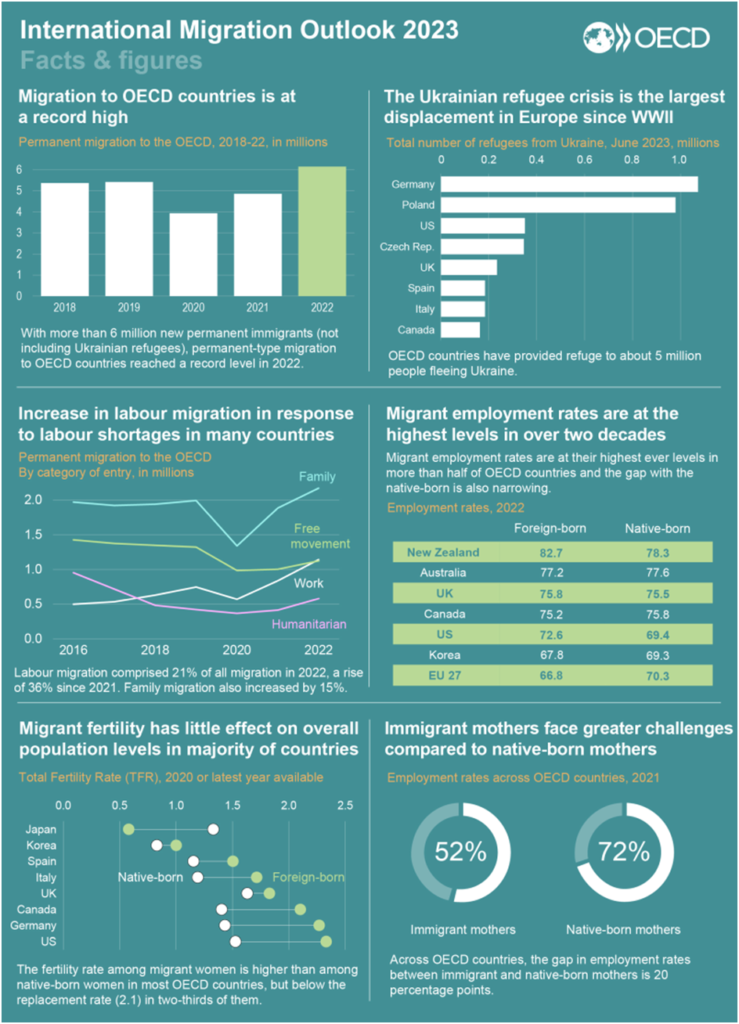Organisation for Economic Co-operation and Development (OECD) recently released International
Migration Outlook 2023.
What is the focus of International Migration Outlook 2023?
The 2023 edition focuses on labour market integration of migrant mothers and on fertility patterns among migrant populations in OECD countries.
What is International Migration Outlook?
The International Migration Outlook is an annual publication by the Organisation for Economic Co-operation and Development (OECD) that provides a comprehensive analysis of international migration trends and their impact on the economies and societies of OECD member countries and selected non-OECD countries.
What are the key findings of International Migration Outlook 2023?

■ India saw the highest migration flows to Organisation for Economic Co-operation and Development (OECD) countries in 2021 and 2022.
■ India replaced China as the main country of origin of new migrants to OECD countries in 2020. In 2021, for the second consecutive year, India, with 0.41 million new migrants, was the top country of origin. It was at the top in 2022 as well.
■ China, with 0.23 million new migrants, was at a distant second, followed by Romania with around 200,000 new migrants.
■ India has been the main origin country of new citizens in OECD countries since 2019. This was despite a recent drop of 15 per cent, compared to 2019.
■ In terms of nationalities, 0.13 million Indian citizens acquired the nationality of an OECD country in 2021.
■ As in previous years, these acquisitions took place mostly in the United States (56,000), Australia (24,000) and Canada (21,000). Mexico again ranked second in 2021, with 0.19 million Mexicans granted nationality of another OECD country, virtually all of them becoming US citizens.
■ In terms of workers, migration flows from India (+172 per cent), Uzbekistan (+122 per cent) and Turkey (+240 per cent) rose sharply, making them primary countries of origin after Ukraine.
■ Policy responses to displacement directly and indirectly impacted by climate change have been gaining interest from policy makers and the international community in recent years.
■ Few OECD countries have introduced explicit policies to respond to climate-induced displacement.
■ Inflows of refugees from Ukraine reached the highest level on record, OECD-wide, due to the ongoing Russia-Ukraine war; more than 10 million people have become either internally displaced or refugees in the OECD region.
Organisation for Economic Co-operation and Development (OECD)
■ The Organisation for Economic Co-operation and Development (OECD) is an intergovernmental organisation with 38 member countries, founded in 1961 to stimulate economic progress and world trade.
■ Established in 1948 as Organisation for European Economic Co-operation (OEEC) and in 1961 reformed into the OECD.

■ The majority of OECD Members are high-income economies ranked as very high in the Human Development Index, and are regarded as developed countries.
■ Their collective population is 1.38 billion.
■ OECD Member countries collectively comprise nearly 62.2% of global nominal GDP (US$49.6 trillion) and 42.8% of global GDP at purchasing power parity.
■ OECD has a number of specialised bodies such as International Energy Agency, Nuclear Energy Agency, etc.
■ The OECD is an official United Nations observer.
■ The OECD’s headquarters are in Paris, France.
